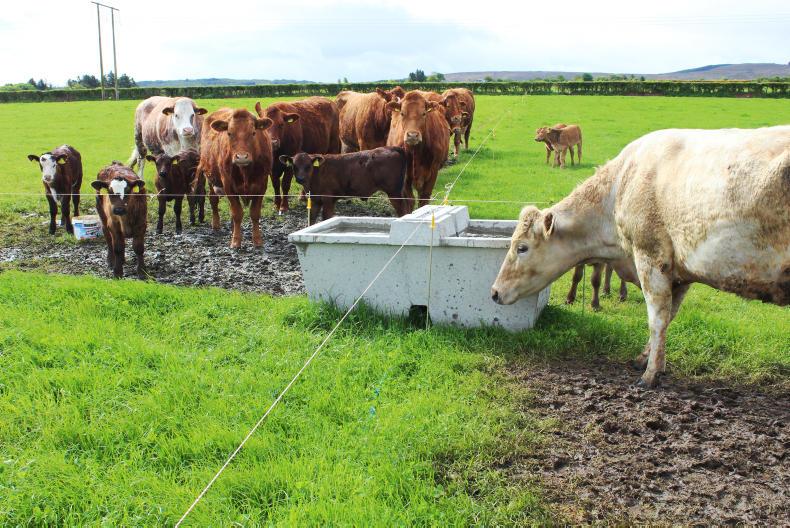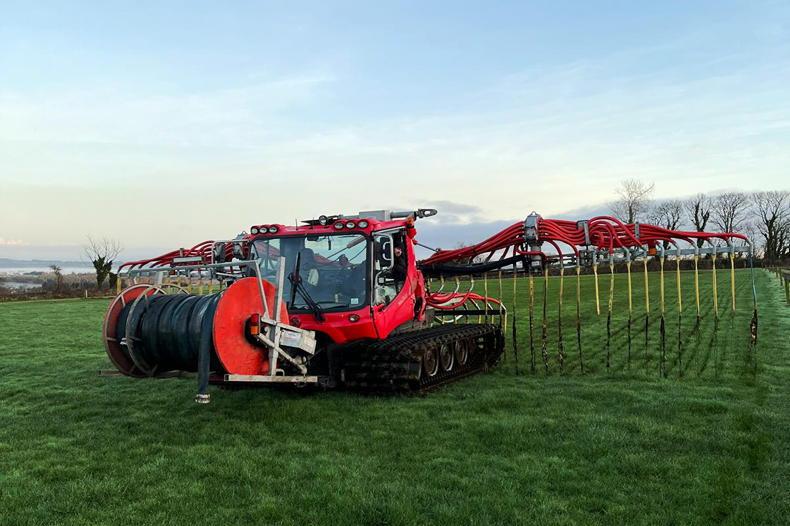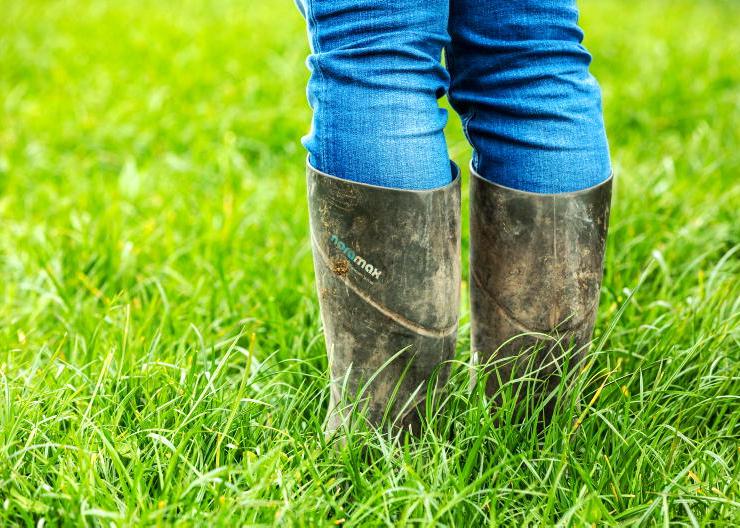With improved grazing conditions, the programme farmers have been filtering cattle out to grass over the past fortnight.
Fertiliser has been applied to grazing swards and grass growth will be increasing week on week towards the period of peak growth rates in late May to early June.
Approximately two thirds of grass is grown during May and June, so it is important that the farms are set up to utilise this grass either through grazing or as baled silage.
Throughout the programme, rotational grazing has been demonstrated as being the best way to manage grassland. When setting up a paddock system, there is no one-size-fits-all blueprint. The key to successful paddock grazing is flexibility.
For instance, when grass growth is at peak levels in May, then it may be necessary to split paddocks in smaller sub-divisions to increase grass utilisation.
In contrast, paddock size can be increased in the season as grass growth slows.
Also, as grazing groups increase or decrease in size, then paddocks need to be altered to suit.
Outlined here are tips to setting up a paddock system which have been implemented on the programme farms.
Paddock size
While paddocks should be flexible, start by making each core grazing area around one to two acres in size.
Paddock size can be reduced later in the year once you have a better handle on gauging the grazing demand of livestock and grass growth.
Once you are confident with matching grass growth to livestock demand, you can then split a paddock using a temporary electric wire to give greater control over grazing.
Where possible, try to keep paddocks as square as possible as this reduces the amount of walking cattle will do during periods of prolonged rainfall.
Number of paddocks
As a rule of thumb, you should grow grass in three weeks and graze it in three days in a rotational grazing system.
Therefore, when setting up a paddock system for the first time, start off with a minimum of seven paddocks.
Any less and cattle are likely to be rotating too quickly, as grass is not getting sufficient time to regrow.
Do not try to do too much too soon. It takes time to adjust to managing cattle in a paddock system
This means there is a risk that animals will run out of grass.
Do not try to do too much too soon. It takes time to adjust to managing cattle in a paddock system.
Therefore, identify one or two areas of the farm to set up paddocks this year.
Focus on getting the system right before trying to set up more paddocks.
Water provision
A common problem that puts farmers off paddock grazing is providing water.
Most fields have one water point, often placed in a corner of a field, which makes it inconvenient for splitting up fields.
However, in fields with one drinking trough, paddocks can still be split diagonally using electric wire to allow some kind of rotation.
There is no need to install a drinker in every paddock.
When moving water troughs on the programme farms, new water piping was rolled out on the ground surface to reduce the installation cost
Water troughs can be strategically placed so that they provide water to multiple paddocks.
For example, moving water troughs to the middle of a field will allow up to four paddocks to be serviced.
Alternatively, water troughs can be moved to a point in a fence where it serves two or more paddocks.
When moving water troughs on the programme farms, new water piping was rolled out on the ground surface to reduce the installation cost.
Piping is buried at a later stage once the paddock setup has been finalised and the water trough is in the best field location.
Fertiliser
With smaller paddocks, it is not practical to fertilise every grazing area individually once grazed.
Instead, the programme farmers still apply fertiliser in bulk by covering multiple paddocks at once.
Once the grazing system is established, it is easier to monitor grass growth and when fertiliser needs to be applied to boost regrowth.
When to move stock
By starting out with fewer paddocks, it is easier to gauge when cattle need to be moved.
This reduces the risk of running out of grass, cattle becoming unsettled and breaking through wire fences.
Ideally, cattle should be moved every third to fourth day.
If there are high covers of residual grass being left behind, do not be tempted to hold cattle in paddocks for a longer time period
Assume that Monday is day one of a three-week rotation.
Start by moving cattle on Monday and Thursday of each week and ensure paddocks are adequately sized for each grazing.
If there are high covers of residual grass being left behind, do not be tempted to hold cattle in paddocks for a longer time period.
Either reduce the size of the paddock in the next rotation or clean off these covers with low-priority animals such as dry cows or sheep.
Energy and protein boost from grazing spring grass
Early turnout has been proven to improve cattle performance through higher liveweight gains and increased milk production in freshly calved cows.
Spring grass has a significantly higher feed value than silage, so the earlier cattle are turned out to fresh grazing the better.
Along with a higher feed value, grazed grass has a much lower cost than silage and labour requirement is also reduced.
Table 1 outlines the feed value of two grazing swards which were analysed last week. Dry matter is relatively good at 22.3% and 26.1%, considering there was heavy rainfall last week.
Energy is excellent at 11.7 and 11.8 Mj ME. Crude protein is the driver of liveweight gain in growing cattle and the analysis of both swards was excellent at 24.7% and 21.1%.
With high digestibility, the overall D-value of the grazing swards was 74% and 73%. The average feed value of first-cut silage analysed on the programme farms was 33.9% dry matter, 11.1 ME, 12.2% crude protein and 70% D-value. Grazing swards at 74% D-value compared with silage at 70% D-value is the equivalent of feeding cattle an extra 1kg of concentrates.
With higher energy, protein and digestibility, the feed comparison shows the value of getting cattle out to grass as early as possible in spring.
Read more
Listen: farmer and adviser reaction at first BETTER Farm walk of 2019
Watch: Newford update - grazing conditions improving after trickier week
With improved grazing conditions, the programme farmers have been filtering cattle out to grass over the past fortnight.
Fertiliser has been applied to grazing swards and grass growth will be increasing week on week towards the period of peak growth rates in late May to early June.
Approximately two thirds of grass is grown during May and June, so it is important that the farms are set up to utilise this grass either through grazing or as baled silage.
Throughout the programme, rotational grazing has been demonstrated as being the best way to manage grassland. When setting up a paddock system, there is no one-size-fits-all blueprint. The key to successful paddock grazing is flexibility.
For instance, when grass growth is at peak levels in May, then it may be necessary to split paddocks in smaller sub-divisions to increase grass utilisation.
In contrast, paddock size can be increased in the season as grass growth slows.
Also, as grazing groups increase or decrease in size, then paddocks need to be altered to suit.
Outlined here are tips to setting up a paddock system which have been implemented on the programme farms.
Paddock size
While paddocks should be flexible, start by making each core grazing area around one to two acres in size.
Paddock size can be reduced later in the year once you have a better handle on gauging the grazing demand of livestock and grass growth.
Once you are confident with matching grass growth to livestock demand, you can then split a paddock using a temporary electric wire to give greater control over grazing.
Where possible, try to keep paddocks as square as possible as this reduces the amount of walking cattle will do during periods of prolonged rainfall.
Number of paddocks
As a rule of thumb, you should grow grass in three weeks and graze it in three days in a rotational grazing system.
Therefore, when setting up a paddock system for the first time, start off with a minimum of seven paddocks.
Any less and cattle are likely to be rotating too quickly, as grass is not getting sufficient time to regrow.
Do not try to do too much too soon. It takes time to adjust to managing cattle in a paddock system
This means there is a risk that animals will run out of grass.
Do not try to do too much too soon. It takes time to adjust to managing cattle in a paddock system.
Therefore, identify one or two areas of the farm to set up paddocks this year.
Focus on getting the system right before trying to set up more paddocks.
Water provision
A common problem that puts farmers off paddock grazing is providing water.
Most fields have one water point, often placed in a corner of a field, which makes it inconvenient for splitting up fields.
However, in fields with one drinking trough, paddocks can still be split diagonally using electric wire to allow some kind of rotation.
There is no need to install a drinker in every paddock.
When moving water troughs on the programme farms, new water piping was rolled out on the ground surface to reduce the installation cost
Water troughs can be strategically placed so that they provide water to multiple paddocks.
For example, moving water troughs to the middle of a field will allow up to four paddocks to be serviced.
Alternatively, water troughs can be moved to a point in a fence where it serves two or more paddocks.
When moving water troughs on the programme farms, new water piping was rolled out on the ground surface to reduce the installation cost.
Piping is buried at a later stage once the paddock setup has been finalised and the water trough is in the best field location.
Fertiliser
With smaller paddocks, it is not practical to fertilise every grazing area individually once grazed.
Instead, the programme farmers still apply fertiliser in bulk by covering multiple paddocks at once.
Once the grazing system is established, it is easier to monitor grass growth and when fertiliser needs to be applied to boost regrowth.
When to move stock
By starting out with fewer paddocks, it is easier to gauge when cattle need to be moved.
This reduces the risk of running out of grass, cattle becoming unsettled and breaking through wire fences.
Ideally, cattle should be moved every third to fourth day.
If there are high covers of residual grass being left behind, do not be tempted to hold cattle in paddocks for a longer time period
Assume that Monday is day one of a three-week rotation.
Start by moving cattle on Monday and Thursday of each week and ensure paddocks are adequately sized for each grazing.
If there are high covers of residual grass being left behind, do not be tempted to hold cattle in paddocks for a longer time period.
Either reduce the size of the paddock in the next rotation or clean off these covers with low-priority animals such as dry cows or sheep.
Energy and protein boost from grazing spring grass
Early turnout has been proven to improve cattle performance through higher liveweight gains and increased milk production in freshly calved cows.
Spring grass has a significantly higher feed value than silage, so the earlier cattle are turned out to fresh grazing the better.
Along with a higher feed value, grazed grass has a much lower cost than silage and labour requirement is also reduced.
Table 1 outlines the feed value of two grazing swards which were analysed last week. Dry matter is relatively good at 22.3% and 26.1%, considering there was heavy rainfall last week.
Energy is excellent at 11.7 and 11.8 Mj ME. Crude protein is the driver of liveweight gain in growing cattle and the analysis of both swards was excellent at 24.7% and 21.1%.
With high digestibility, the overall D-value of the grazing swards was 74% and 73%. The average feed value of first-cut silage analysed on the programme farms was 33.9% dry matter, 11.1 ME, 12.2% crude protein and 70% D-value. Grazing swards at 74% D-value compared with silage at 70% D-value is the equivalent of feeding cattle an extra 1kg of concentrates.
With higher energy, protein and digestibility, the feed comparison shows the value of getting cattle out to grass as early as possible in spring.
Read more
Listen: farmer and adviser reaction at first BETTER Farm walk of 2019
Watch: Newford update - grazing conditions improving after trickier week










SHARING OPTIONS